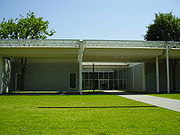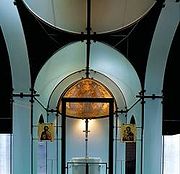
Menil Collection
Encyclopedia


John de Menil
John de Menil was an American businessman, philanthropist, and art patron. He was the founding president of the International Foundation for Art Research in New York.-Life:...
and Dominique de Menil
Dominique de Menil
Dominique de Menil was a French-American art collector, philanthropist, founder of the Menil Collection and an heiress to the Schlumberger Limited oil-equipment fortune...
, or to the collection itself. Dominique was an heir to the Schlumberger oil-drilling fortune, and John was an executive of that company.
Background
The Renzo PianoRenzo Piano
Renzo Piano is an Italian architect. He is the recipient of the Pritzker Architecture Prize, AIA Gold Medal, Kyoto Prize and the Sonning Prize...
-designed museum opened to the public in June 1987 and houses John and Dominique de Menils' privately-assembled collection of twentieth-century art, including over 15,000 paintings, sculptures, prints, drawings, photographs, and rare books. It includes the early to mid-twentieth century works of Yves Tanguy
Yves Tanguy
Raymond Georges Yves Tanguy , known as Yves Tanguy, was a French surrealist painter.-Biography:Tanguy was born in Paris, France, the son of a retired navy captain. His parents were both of Breton origin...
, René Magritte
René Magritte
René François Ghislain Magritte[p] was a Belgian surrealist artist. He became well known for a number of witty and thought-provoking images...
, Max Ernst
Max Ernst
Max Ernst was a German painter, sculptor, graphic artist, and poet. A prolific artist, Ernst was one of the primary pioneers of the Dada movement and Surrealism.-Early life:...
, Man Ray
Man Ray
Man Ray , born Emmanuel Radnitzky, was an American artist who spent most of his career in Paris, France. Perhaps best described simply as a modernist, he was a significant contributor to both the Dada and Surrealist movements, although his ties to each were informal...
, Marcel Duchamp
Marcel Duchamp
Marcel Duchamp was a French artist whose work is most often associated with the Dadaist and Surrealist movements. Considered by some to be one of the most important artists of the 20th century, Duchamp's output influenced the development of post-World War I Western art...
, Henri Matisse
Henri Matisse
Henri Matisse was a French artist, known for his use of colour and his fluid and original draughtsmanship. He was a draughtsman, printmaker, and sculptor, but is known primarily as a painter...
and Pablo Picasso
Pablo Picasso
Pablo Diego José Francisco de Paula Juan Nepomuceno María de los Remedios Cipriano de la Santísima Trinidad Ruiz y Picasso known as Pablo Ruiz Picasso was a Spanish expatriate painter, sculptor, printmaker, ceramicist, and stage designer, one of the greatest and most influential artists of the...
among others. The museum also maintains an extensive collection of pop art
Pop art
Pop art is an art movement that emerged in the mid 1950s in Britain and in the late 1950s in the United States. Pop art challenged tradition by asserting that an artist's use of the mass-produced visual commodities of popular culture is contiguous with the perspective of fine art...
and contemporary art
Contemporary art
Contemporary art can be defined variously as art produced at this present point in time or art produced since World War II. The definition of the word contemporary would support the first view, but museums of contemporary art commonly define their collections as consisting of art produced...
from Jackson Pollock
Jackson Pollock
Paul Jackson Pollock , known as Jackson Pollock, was an influential American painter and a major figure in the abstract expressionist movement. During his lifetime, Pollock enjoyed considerable fame and notoriety. He was regarded as a mostly reclusive artist. He had a volatile personality, and...
, Andy Warhol
Andy Warhol
Andrew Warhola , known as Andy Warhol, was an American painter, printmaker, and filmmaker who was a leading figure in the visual art movement known as pop art...
, Mark Rothko
Mark Rothko
Mark Rothko, born Marcus Rothkowitz , was a Russian-born American painter. He is classified as an abstract expressionist, although he himself rejected this label, and even resisted classification as an "abstract painter".- Childhood :Mark Rothko was born in Dvinsk, Vitebsk Province, Russian...
, Robert Rauschenberg
Robert Rauschenberg
Robert Rauschenberg was an American artist who came to prominence in the 1950s transition from Abstract Expressionism to Pop Art. Rauschenberg is well-known for his "Combines" of the 1950s, in which non-traditional materials and objects were employed in innovative combinations...
and Cy Twombly
Cy Twombly
Edwin Parker "Cy" Twombly, Jr. was an American artist well known for his large-scale, freely scribbled, calligraphic-style graffiti paintings, on solid fields of mostly gray, tan, or off-white colors...
, among others. Also included in the museum's permanent collection are Antiquities
Antiquities
Antiquities, nearly always used in the plural in this sense, is a term for objects from Antiquity, especially the civilizations of the Mediterranean: the Classical antiquity of Greece and Rome, Ancient Egypt and the other Ancient Near Eastern cultures...
and works of Byzantine
Byzantine art
Byzantine art is the term commonly used to describe the artistic products of the Byzantine Empire from about the 5th century until the Fall of Constantinople in 1453....
, Medieval
Medieval art
The medieval art of the Western world covers a vast scope of time and place, over 1000 years of art history in Europe, and at times the Middle East and North Africa...
and Tribal art
Tribal art
Tribal art is an umbrella term used to describe visual arts and material culture of indigenous peoples. Also known as Ethnographic art, or, controversially, Primitive Art, tribal arts have historically been collected by Western anthropologists, private collectors, and museums, particularly...
.
Admissions
The Menil Collection is open to the public, and admission is free. The Museum is open Wednesday through Sunday 11 am to 7 pm. It is located near the University of St. ThomasUniversity of St. Thomas (Houston)
The University of St. Thomas in Houston, Texas, United States is a comprehensive Catholic university, grounded in the liberal arts...
in the Neartown
Neartown Houston
Neartown is an area located in west-central Houston, Texas, United States and is one of the city's major cultural areas. Neartown is roughly bounded by U.S. Highway 59 to the south, Allen Parkway to the north, Bagby Street on the east, and Shepherd Drive to the west...
area of Houston.
Campus and Neighborhood
The museum campus has grown to include two satellite galleries to the main building: Cy TwomblyCy Twombly
Edwin Parker "Cy" Twombly, Jr. was an American artist well known for his large-scale, freely scribbled, calligraphic-style graffiti paintings, on solid fields of mostly gray, tan, or off-white colors...
Gallery (also designed by Piano) and The Dan Flavin Installation at Richmond Hall, which houses Mrs. de Menil's last commission (a series of three site-specific installations by Dan Flavin
Dan Flavin
Dan Flavin was an American minimalist artist famous for creating sculptural objects and installations from commercially available fluorescent light fixtures.-Early life and career:...
that were installed in 1998). Two other buildings founded by the de Menils, but now operating as independent foundations complete the campus: The Byzantine Fresco Chapel
Byzantine Fresco Chapel Museum
The ' is a part of the Menil Collection in Houston, Texas, near the University of St. Thomas, and displays the only intact Byzantine frescoes of this size and importance in the entire western hemisphere. The Byzantine frescoes were taken from the church of St...
and the Rothko Chapel
Rothko Chapel
The Rothko Chapel is a non-denominational chapel in Houston, Texas founded by John and Dominique de Menil. The interior serves not only as a chapel, but also as a major work of modern art. On its walls are fourteen black but color hued paintings by Mark Rothko...
. The museum has a library that is open to qualified researchers by appointment and a bookstore open during museum hours.
The neighborhood as a whole has a coordinated feel. The Menil Foundation began buying homes in the area in the 1960s and painting them the same shade of gray over time. When the museum building was constructed, it too was painted 'Menil gray.' Though subtle, the result is a neighborhood that feels aesthetically unified. Currently the surrounding bungalows are used as additional office space for museum employees, or rented to individuals or non-profit organizations.
Rothko Chapel

The Rothko Chapel, built in 1971, is an interfaith chapel commissioned by the de Menils. The entrance-way contains holy books from various religious traditions that may be used in the chapel. The space is sky-lit, with kneeling mats, prayer benches, and meditation cushions. The walls are covered with several large paintings. The Rothko Chapel is an independent, non-profit organization.
South of the entrance is a reflecting pool with the sculpture Broken Obelisk
Broken Obelisk
thumb|270px|Broken Obelisk in front of [[Rothko Chapel]] in [[Houston]], [[Texas]].Broken Obelisk is a 1963 sculpture by Barnett Newman. It is the largest and best known of his six sculptures. It is made from three tons of Cor-Ten steel which acquired a rust-colored patina.Broken Obelisk was...
by Barnett Newman
Barnett Newman
Barnett Newman was an American artist. He is seen as one of the major figures in abstract expressionism and one of the foremost of the color field painters.-Early life:...
, installed here in memory of Martin Luther King, Jr.
Martin Luther King, Jr.
Martin Luther King, Jr. was an American clergyman, activist, and prominent leader in the African-American Civil Rights Movement. He is best known for being an iconic figure in the advancement of civil rights in the United States and around the world, using nonviolent methods following the...
The Byzantine Fresco Chapel

Located in a separate building near the main collection, the Byzantine Fresco Chapel houses two 13th century Byzantine
Byzantine art
Byzantine art is the term commonly used to describe the artistic products of the Byzantine Empire from about the 5th century until the Fall of Constantinople in 1453....
church frescos, an apse
Apse
In architecture, the apse is a semicircular recess covered with a hemispherical vault or semi-dome...
semi-dome of the Virgin Panagia
Panagia
Panagia , also transliterated Panayia or Panaghia, is one of the titles of Mary, the mother of Jesus, used especially in Orthodox Christianity....
and a dome with Christ Pantocrator
Christ Pantocrator
In Christian iconography, Christ Pantokrator refers to a specific depiction of Christ. Pantocrator or Pantokrator is a translation of one of many Names of God in Judaism...
(pictures on website). These were recovered from the illegal art trade, which removed them from a church in Lysi
Lysi
Lysi is a village located in the Mesaoria plain of the Famagusta district of Cyprus, north of the city of Larnaca.In 1960, there were 3,700 Greek Cypriots living in the village and approximately 6,000 in 1974 when they all fled because of the Turkish invasion and occupation of the north part of...
in Turkish-occupied North Cyprus
Turkish Republic of Northern Cyprus
Northern Cyprus or North Cyprus , officially the Turkish Republic of Northern Cyprus , is a self-declared state that comprises the northeastern part of the island of Cyprus...
during the 1980s. According to the museum they are the only such frescoes in the Americas. They are held at the museum by agreement with the Church of Cyprus, their owners.
In September 2011 the Collection announced that the frescos would be permanently returned to Cyprus in February 2012, an example of art repatriation
Art repatriation
Art repatriation is the return of art or cultural objects, usually referring to ancient or looted art, to their country of origin or former owners . The disputed cultural property items are physical artifacts of a group or society that were taken from another group usually in an act of looting,...
. The future use of the chapel remains undecided.

